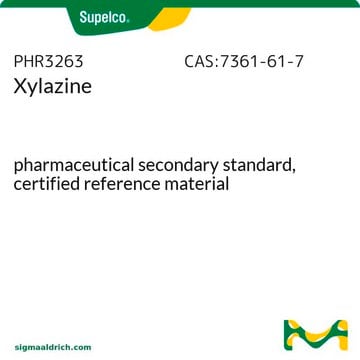V-006
Valproic acid solution
1.0 mg/mL in methanol, ampule of 1 mL, certified reference material, Cerilliant®
About This Item
Produtos recomendados
grau
certified reference material
Nível de qualidade
Formulário
liquid
Características
Snap-N-Spike®/Snap-N-Shoot®
embalagem
ampule of 1 mL
fabricante/nome comercial
Cerilliant®
concentração
1.0 mg/mL in methanol
técnica(s)
gas chromatography (GC): suitable
liquid chromatography (LC): suitable
aplicação(ões)
clinical testing
Formato
single component solution
temperatura de armazenamento
−20°C
cadeia de caracteres SMILES
CCCC(CCC)C(O)=O
InChI
1S/C8H16O2/c1-3-5-7(6-4-2)8(9)10/h7H,3-6H2,1-2H3,(H,9,10)
chave InChI
NIJJYAXOARWZEE-UHFFFAOYSA-N
Informações sobre genes
human ... ALDH5A1(7915)
Descrição geral
Informações legais
Palavra indicadora
Danger
Frases de perigo
Declarações de precaução
Classificações de perigo
Acute Tox. 3 Dermal - Acute Tox. 3 Inhalation - Acute Tox. 3 Oral - Flam. Liq. 2 - STOT SE 1
Órgãos-alvo
Eyes,Central nervous system
Código de classe de armazenamento
3 - Flammable liquids
Classe de risco de água (WGK)
WGK 2
Ponto de fulgor (°F)
49.5 °F - closed cup
Ponto de fulgor (°C)
9.7 °C - closed cup
Escolha uma das versões mais recentes:
Certificados de análise (COA)
It looks like we've run into a problem, but you can still download Certificates of Analysis from our Documentos section.
Se precisar de ajuda, entre em contato Atendimento ao cliente
Já possui este produto?
Encontre a documentação dos produtos que você adquiriu recentemente na biblioteca de documentos.
Active Filters
Nossa equipe de cientistas tem experiência em todas as áreas de pesquisa, incluindo Life Sciences, ciência de materiais, síntese química, cromatografia, química analítica e muitas outras.
Entre em contato com a assistência técnica











